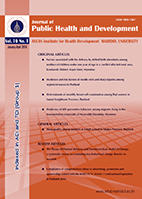Incidence and risk factors of needle stick and sharp injuries among registered nurses in Thailand
Main Article Content
Abstract
Needle stick and sharp injuries (NSIs) and persistent needle stick and sharp injuries (PNSIs) are serious occupation hazards among registered nurses (RNs). This study aims to estimate the incidence rate of NSIs and PNSIs and identify risk factors of PNSIs. Data from the first wave of the Thai Nurse Cohort Study, where cohort members were enrolled in 2009 and the second wave, a 3-year follow-up survey in 2012 were analyzed. NSIs were defined as self-reported NSIs during the previous 12 months in either wave, while PNSIs were those who reported NSIs in both waves.
Among 13,754 RNs in wave 1, the incidence rate was 0.27 per person-years (95% CI= 0.26-0.28). Wave 2 included 8,238 RNs who remained in the study, where the incidence rate of NSIs was 0.17 per person-years (95%CI= 0.16-0.18). The NSIs had reduced by 48% after the 3-year follow-up (OR = 0.52; 95%CI= 0.47-0.57). The prevalence of PNSI was 17.4%, based on the total number of 240 RNs who reported persistent NSI. The strongest risk factor of PNSI was working on night shifts for > 16 shifts per month (Adj OR=3.20; 95%CI= 1.70-6.00) compared to not working night shifts.
In the context of blood borne infections, universal precaution and prevention of NSI is critical to safeguard health workforce. Nurses especially those who work in night shifts should be taught preventative strategies against NSIs and PNSIs. PNSI is an indicator reflecting failure of preventive measures.

